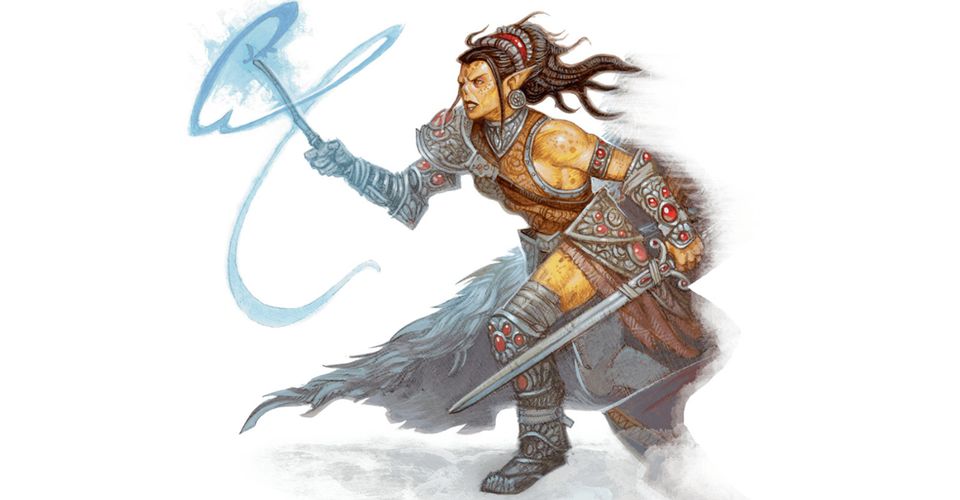What A D&D “Gish” Character Build Is (& How To Make One)

Tabletop gaming fans who hang around a Dungeons & Dragonscampaign group may hear one of the players say “I think I’ll make my next character a “Gish” and wonder: “what exactly is a “Gish?” This article will explain the origins of the term “Gish” in 1980s Advanced Dungeon & Dragons, its adoption by D&D players as a term for warrior/wizard hybrid characters, and the many interesting “Gish” character builds player can make in Dungeons & Dragons 5th Edition.
There’s an official Dungeons & Dragons species called the Gith, psionic dwellers of the Astral Plane and mortal enemies of the Mind Flayers (both these species have a major role in the Baldur’s Gate 3 early access computer RPG). One branching of the Gith, called the Githyanki, are famed for their imperialism, their cruel xenophobia, their relentless hunting of Mind Flayers, and elite champions called “Gish,” described in the 1980s Fiend Folio and 1990s Planescape sourcebooks as warriors with the martial prowess of a Fighter and the arcane knowledge of Wizard.
The in-universe term “Gish” has since been adopted by D&D veterans to describe character builds skilled in both physical combat and offensive magic – “squishy wizards” who can actually take a hit, and “meat shields” who can drop a fireball into a horde of zombies. In D&D, an RPG system where most D&D character classes are specialized into specific roles, a cleverly crafted “Gish” character can take on almost any role in an adventuring party, embracing versatility without sacrificing too much raw power (particularly if players grab the “War Caster” feat).
Dungeons & Dragons 5e Subclasses Considered “Gish”

In Dungeons & Dragons 5th Edition, there are several character classes capable of competently swinging a sword and casting a spell: Clerics, Paladins, and Rangers blend frontline melee survivability with divine magic, while Bladesinger-subclass Wizards and Arcane Trickster-subclass Rogues can take the offensive with both stabbing and blasting. To be a truly versatile “Gish,” though, a character build must have the weapon and armor proficiency of a Fighter Class plus the magical power of a Wizard or Sorcerer. Luckily for aspiring magic knights, a few sub-classes and multi-class combinations let D&D PCs play the role of both meat-shield and magician.
The simplest, most straightforward way to make a Githyanki-style “Gish” build in D&D 5e is to choose the Fighter class, then pick the “Eldritch Knight” sub-class at 3rd level. An Eldritch Knight has all the signature abilities of a Fighter, a small but useful selection of arcane spells (mostly evocation and abjuration) and abilities like “War Magic” and “Eldritch Strike” that let them attack with weapons and cast a spell in the same turn.
Alternately, players can embrace their inner sword-juggler/warrior-poet by picking the College of Swords or College of Valor Bard D&D subclasses, which grant medium armor proficiency, facility with martial weapons, and special abilities to supplement their enchantment spells with melee attack options.
A Battle Smith or Armorer-subclass Artificer, as seen in the Eberron sourcebook, can craft magical weapons and armor for themselves while casting Wizard-style spells through the wielding of magic tools. Finally, a Warlock with the sub-class of Hexblade and the Pact Of The Blade Boon gains access to medium armor proficiency, all martial weapons, special curse abilities to increase their weapon damage, and the ability to make melee attacks solely using their Charisma attribute.
Dungeons & Dragons 5e Multiclass “Gish” Builds

To make an optimal multi-class “Gish” build in Dungeons & Dragons 5th edition, player must be able to assign plenty of points to their primary melee attack attribute (Strength or Dexterity) and primary spell-casting attribute (Intelligence, Wisdom, or Charisma) while still keeping their Constitution attribute rating (their source of Hit Points) at a respectable level. The Rogue, which specializes in Dexterity, and the Fighter, capable of specializing in Strength or Dexterity, are very easy to mix with spell-casting classes like the Sorcerer and Wizard (especially since players need only take a few levels in Rogue or Fighter to get their iconic features and weapon proficiencies).
The original “Gish” of classic Dungeons & Dragons was a Fighter/Wizard multi-class, which still works well in D&D 5th edition; a Fighter with some levels in Wizard gains useful spells for ranged offense and general utility, while a Wizard with some levels in Fighter gets a lot tougher and can cast multiple spells in a single round of combat with the “Action Surge” feature. Hybrid classes like the Monk of Ranger are trickier to use in multi-class builds, since their class abilities rely on two attributes rather than one (Dexterity and Wisdom, generally): Monks and Rangers generally multi-class best with Wisdom-focused spell-casters like Clerics and Druids, who don’t quite have the sheer destructive potential of Arcane spell-casting classes.
Among the martial classes in in Dungeons & Dragons 5th edition, the Paladin has exceptional synergy with Bards, Sorcerers, and Warlocks, thanks to all four of these classes relying on Charisma for their Arcane spell-casting. A “Hexadin” – a Paladin/Hexblade Warlock – can pump most of their points into Charisma, using this attribute for both spells and melee attacks. A “Sorcadin” can use the Sorcerer Classes’s Metamagic option to attack with spells and blades on the same turn, while D&D’s Bard mixed with a Paladin has a vast bag of tricks for supporting their party members and keeping them in the fight.
Core to all three of these D&D builds is the Paladin’s “Divine Smite” feature, which lets them boost the damage of a successful weapon strike by burning up one of their spell-slots; the higher level the spell-slot, the greater the extra radiant damage. By multi-classing into any charismatic spell-casting class, a Paladin gets more spells to fuel their “Divine Smite” ability with, and high-level spell-slots to make each smite hit harder.
About The Author

















